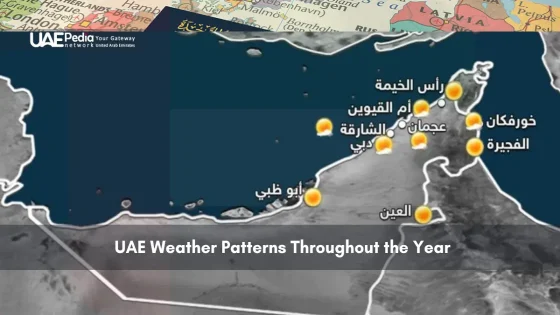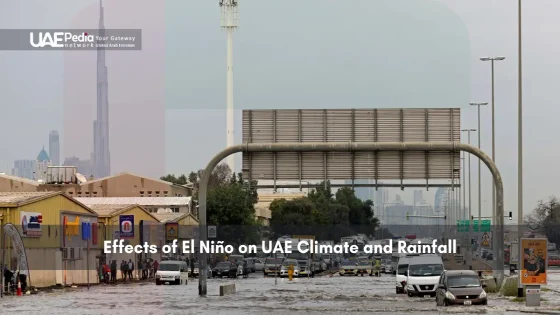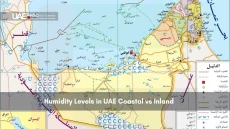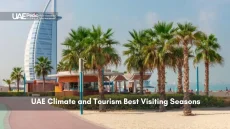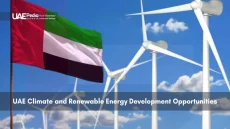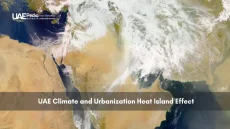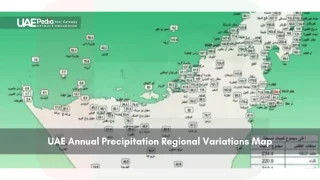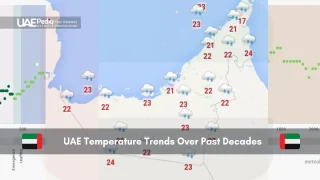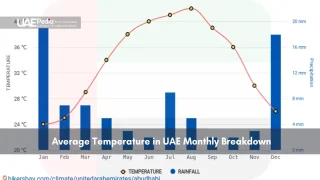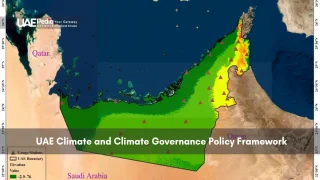Did you know Dubai’s summer asphalt can hit 73°C (163°F)—hot enough to literally fry an egg? Yet by winter, residents bundle up when temperatures dip to 12°C (54°F). This wild swing defines life in a land where sunshine reigns supreme, but surprises lurk behind every sand dune.
Whether you’re planning a desert safari or a downtown stroll, understanding seasonal shifts here is crucial. Morning fog blankets coastal highways in January. July brings humidity so thick it feels like walking through soup. And those Instagram-perfect rainstorms? They’re real—brief but dramatic winter downpours that transform wadis into rushing streams.
We’ve packed this guide with local secrets and hard data to help you navigate the Emirates’ climate. You’ll learn why February is ideal for dune bashing, how cloud seeding creates artificial rain, and where to find relief when summer heat peaks. From Abu Dhabi’s breezy corniches to Ras Al Khaimah’s mountain chills, every emirate has its microclimate quirks.
Key takeaways:
- Avoid midday outdoor plans June-August—shade temps still hit 43°C+
- Winter (Nov-Mar) offers perfect beach weather + rare rainy adventures
- Sandstorms arrive unannounced; learn the Arabic term shamal (north wind)
- Year-round sunscreen is non-negotiable—UV index rarely drops below 8
General Climate Overview in the United Arab Emirates
Picture a land where skyscrapers meet sand dunes, and coastal breezes battle desert heat. The nation’s climate acts like a mood ring—changing dramatically between coastal cities and inland expanses. Three geographic giants shape this dance: the Persian Gulf’s warm embrace, the Hajar Mountains’ rugged spine, and the Rub’ Al Khali’s endless sands.
Geographical Influences on Climate
Coastal areas like Abu Dhabi get double trouble—sea humidity meets urban heat from glass towers. Meanwhile, desert towns face 50°C (122°F) summer days but surprisingly crisp winter nights. The Hajar Mountains create their own rules, with wadis (dry riverbeds) that flash-flood during rare rains.
- Persian Gulf: Adds sticky humidity to coastal cities
- Urban centers: Concrete jungles trap 5-7°C more heat than suburbs
- Empty Quarter desert: Creates extreme temperature swings
Annual Temperature and Precipitation Trends
Modern humidity data shows coastal summers averaging 90% moisture levels—think steamy subway stations. Winter brings relief, with January lows of 12°C (54°F) in Dubai. Check how temperatures stack up:
| Location | Summer High | Winter Low |
|---|---|---|
| Downtown Dubai | 45°C (113°F) | 14°C (57°F) |
| Abu Dhabi Suburbs | 43°C (109°F) | 12°C (54°F) |
These patterns aren’t just natural—skyscraper clusters and irrigation projects tweak local climates daily. Pack your sunglasses, but keep an umbrella handy November-March!
Distinct Seasons: Scorching Summers and Mild Winters
Step outside in July and you’ll feel like a cookie in a convection oven—air so thick with heat and dust it sticks to your skin. By December, that same breeze turns crisp enough to make you reach for a light sweater. This isn’t just a climate shift—it’s a full sensory reboot.
When the Sun Takes Over
June through August transforms the Emirates into a giant sauna. Thermometers regularly hit 43°C (109°F), but urban heat islands add extra sizzle. “It’s like walking through hairdryer exhaust,” laughs Dubai resident Amal Khalid. Humidity along the coast cranks up to 90%, creating that infamous “shirt-stuck-to-your-back” feeling by 9 AM.
Three major challenges define these months:
- Dust demons: Shamal winds whip up 40+ visibility-reducing storms annually
- Night sweats: Temperatures rarely dip below 30°C (86°F) after dark
- UV overload: The sun’s intensity fries unprotected skin in under 15 minutes
Winter’s Gentle Embrace
Come November, the landscape exhales. Daytime highs settle around 26°C (79°F)—perfect for beach picnics or exploring varied climate zones. Clear skies dominate, though December and January bring 80% of the year’s rainfall. These aren’t drizzles—think cinematic downpours that flood wadis but vanish by lunchtime.
| Season | Avg. High | Rain Days | Unique Prep |
|---|---|---|---|
| Summer | 43°C | 0.2/month | Cooling towels |
| Winter | 26°C | 4/month | Light jackets |
Locals joke that winter here feels like “summer lite” to northern visitors. But when Dubai recorded its coldest night ever at 6°C (43°F) in 2017, even Emiratis dug out rarely-used sweaters. These extremes shape everything from construction schedules to school uniforms—proof that in this desert kingdom, we dance to the sun’s tune.
Monthly Weather Insights in the UAE
Flip through any Emirates calendar and you’ll find twelve unique characters—each month bringing its own climate personality. Let’s crack the code on temperature swings, rare rains, and humidity rollercoasters that shape local lifestyles.
Thermometer Tales and Rain Gauges
January starts cool with 24°C (75°F) daytime averages—perfect for desert camping. By May, thermometers hit 38°C (100°F) as pools become survival essentials. Check how precipitation plays peek-a-boo:
| Month | Avg High | Rainfall | Surprise Factor |
|---|---|---|---|
| February | 26°C | 35mm | Wettest month |
| July | 41°C | 1mm | 100% humidity spikes |
| November | 31°C | 10mm | Sudden wadi floods |
Daylight and Dew Points
June serves marathon sunlight—13.5 daily hours to roast beachgoers. December cuts it to 10.5, with golden-hour photography opportunities. Humidity tells its own story:
| Period | Sun Hours | Humidity Avg | Smart Move |
|---|---|---|---|
| Mar-May | 11.2 | 65% | Morning outings |
| Sep-Nov | 10.8 | 75% | UV-blocking clothes |
Pro tip from tour guide Fatima Al-Mansoori: “December mornings often dip to 15°C (59°F)—pack layers even if you’re coming for warmth.” These monthly quirks explain why savvy visitors schedule outdoor adventures between October and April.
Key UAE Weather Patterns and Climate Data
Think of the Arab Emirates’ climate as a living archive—each decade adds new chapters to its thermal story. Let’s crunch numbers like dates at a souk, comparing Dubai’s concrete jungles with Abu Dhabi’s coastal rhythms.
Historical records reveal startling shifts. Since 2000, summer temps climbed 1.2°C in urban areas—twice the global average. “Our nights are getting stickier,” notes climate researcher Dr. Aisha Al-Hammadi. “June humidity now averages 91% versus 84% in the 1990s.”
| City | 1990s Summer Avg | 2020s Summer Avg | Change |
|---|---|---|---|
| Dubai | 40.1°C | 41.3°C | +1.2°C |
| Abu Dhabi | 38.9°C | 40.0°C | +1.1°C |
Three months tell the clearest story:
- April: Now sees 3 more 40°C days than 20 years ago
- December: Rainfall increased 22% since 2010
- August: Nighttime lows rose 2.4°C in desert areas
Coastal cities trap heat like clay ovens, while rural zones cool faster after sunset. February showcases this best—Dubai Marina stays 5°C warmer at night than Al Ain’s date farms.
| Area Type | Day Temp Range | Night Temp Drop |
|---|---|---|
| Urban | 8°C | 4-6°C |
| Rural | 12°C | 8-10°C |
These patterns matter for future planning. That surprise 2009 downpour? It dumped 128mm on Al Ain in hours—a 50-year record. Now cloud seeding aims to harness such anomalies. As seasons shift, one truth remains: in this land of extremes, every degree tells a story.
Extreme Weather Events and Sandstorms in the Region
April 18, 2008, rewrote the rulebook for desert drama. A monstrous sandstorm swallowed Dubai whole, reducing visibility to 500 meters and grounding flights for hours. “It felt like someone poured coffee creamer into the sky,” recalls longtime resident Yusuf Al-Mazroui. These events showcase nature’s raw power in a land where heat and wind conspire to reshape reality.
Notable Sandstorm Incidents
Three record-breaking moments reveal the region’s fiery personality:
- 2017 Heat Spike: Al Ain thermometers hit 52.1°C (126°F)—highest ever recorded
- 2009 Rain Surprise: 128mm deluge flooded Al Quaa in 24 hours—a decade’s average rainfall
- 2021 Dust Drama: 18-hour storm turned Abu Dhabi’s Corniche into a Martian landscape
Nighttime offers no refuge during these events. Summer sandstorms often strike after dark, with winds reaching 70 km/h (43 mph). Highway cameras captured eerie scenes in 2022—cars crawling through orange haze with hazard lights blinking like fireflies.
Smart survival starts with preparation:
- Carry N95 masks during March-June storm season
- Download the NCM Weather app for real-time alerts
- Seal windows with damp towels when dust clouds approach
These extremes remind us that even in our climate-controlled era, nature still holds the remote control. As one Bedouin proverb warns: “The desert writes its poetry in sand and wind—we merely learn the verses.”
Impact of Global Climate Changes and Weather Management Techniques
Imagine flipping a switch to summon rain—it’s not sci-fi here. The Emirates now battles rising heat and dwindling water supplies with tech that would make Bond villains jealous. Natural shifts meet human ingenuity in this high-stakes climate chess match.
Rainmakers of the 21st Century
Cloud seeding pilots here don’t just fly through storms—they create them. “We’re essentially giving clouds a caffeine boost,” explains meteorologist Dr. Omar Al-Haddad. Salt flares fired into moisture-heavy clouds trigger rainfall 15% more efficiently than natural downpours, according to 2023 data.
Three numbers tell the story:
- 1,274 seeding flights launched since 2020
- 35% humidity jump in coastal areas since 2015
- 4-hour window to capture rain before it evaporates
This isn’t just about filling reservoirs. Artificial rains cool cities during brutal summers and rinse dust from solar farms. A 2021 project over Abu Dhabi’s Liwa Desert increased seasonal rainfall by 15%—enough to fill 57 Olympic pools.
| Year | Seeding Flights | Rain Increase | Water Saved (Million Liters) |
|---|---|---|---|
| 2020 | 214 | 12% | 380 |
| 2023 | 487 | 18% | 1,240 |
But there’s a catch. Warmer Gulf waters pump extra moisture into air already heavy with urban pollution. The result? Summer haze that lingers like uninvited guests. New desalination plants now produce 42% of the nation’s drinking water—a necessary backup when nature plays hardball.
As Dr. Al-Haddad notes: “We’re not controlling the climate—we’re learning its rhythm to dance better.” From drones that zap clouds with electric pulses to AI predicting dry periods, this desert nation keeps rewriting the rules of atmospheric survival.
Travel Insights: Best Times to Experience UAE’s Climate
Ever wondered when those iconic turquoise waters feel like bathwater? We’ve decoded the sweet spots where golden sands meet ideal conditions. November through March steals the show—think 25°C (77°F) days perfect for sipping karak chai on Jumeirah Beach.
Tourism Scores and Seasonal Recommendations
February’s magic lies in balance—temperatures hover around 28°C (82°F) with near-zero rain. This is when planning your desert safari pays off: cool mornings for dune bashing, warm afternoons for camel treks. Check our insider chart:
| Month | Beach Score | Cultural Events | Pro Tip |
|---|---|---|---|
| Dec | 9.2/10 | National Day Festivals | Book brunch cruises early |
| Mar | 8.7/10 | Art Dubai | Pack reef-safe sunscreen |
| Nov | 8.9/10 | Abu Dhabi Grand Prix | Evening light jackets |
April brings a shift—peak sea temperatures reach 33°C (91°F), turning swims into liquid bliss. But watch the clock: midday heat can spike to 38°C (100°F). Smart travelers book waterpark mornings and museum afternoons.
Come July, humidity levels hit 90%+ along the coast. While poolside cocktails still tempt, occasional dust storms may cancel desert plans. This is when indoor marvels shine—think Louvre Abu Dhabi’s AC-cooled galleries or Dubai Mall’s underwater zoo.
Local wisdom: “Visit in January for calm seas and festival energy,” advises Emirates tour guide Layla Al-Maktoum. “But pack layers—desert nights dip to 15°C (59°F) when campfire stories begin.”
Final Reflections on UAE Climate Trends
Imagine reading a storybook where each chapter swings between fiery deserts and breezy coasts—that’s the Emirates’ climate diary. Over the past 20 years, temperatures here have climbed 1.2°C in urban zones, turning summer nights into sticky sagas. Yet winter still delivers its magic: crisp 15°C mornings perfect for sipping karak tea under palm fronds.
Three numbers tell the tale of adaptation:
- 43°C: Average summer daytime highs that demand smart scheduling
- 4X: Increase in December rainfall since 2010, creating flash-flood adventures
- 90%: Coastal humidity levels that transform simple walks into sweat-soaked challenges
This isn’t just about surviving the heat—it’s about thriving through rhythm. Those golden-hour beach days in February? They’re balanced by July’s indoor exploration windows. Modern data paints a clear path: check hourly forecasts, embrace layering, and respect the desert’s mood swings.
Every degree here tells two stories—the thrill of dune sunrises and the relief of AC-blasted cars. As you plan adventures, let these insights be your compass. For deeper dives into shifting trends, uaepedia.net lights the way. After all, in this land of contrasts, preparation turns climate quirks into lifelong memories.
August sizzles as the peak of summer—average highs hit 104°F (40°C) in Dubai and Abu Dhabi. Coastal humidity makes it feel even hotter, while desert areas bake under relentless sun.
Yes! Winter months (December–March) bring brief showers, averaging 1–2 inches yearly. Mountainous regions like Ras Al Khaimah see more frequent drizzles, while cities might go months without a drop.
A> Dusty “shamal” winds blow mainly in summer, reducing visibility for days. Major storms occur 3–5 times yearly—pack sunglasses, scarves, and check weather apps before desert adventures.
November–February offers golden hours: 75°F (24°C) days, cool evenings, and minimal rain. Perfect for dune bashing, beach days, or exploring Al Ain’s oasis trails without melting your sunscreen.
Planes inject salt flares into moisture-rich clouds, boosting rainfall by 15–35%. The UAE pioneered this tech to combat aridity—though you’ll still need that hotel pool pass most days!
By local standards, yes! January nights dip to 57°F (14°C)—Emiratis break out light jackets. But compared to snowy climates, it’s still flip-flop weather by midday.
Fujairah’s east coast location cuts summer heat by 5–7°F (2–4°C) versus Dubai. Coastal breezes and Hajar Mountain shade make it a hidden refuge when inland temps soar.
